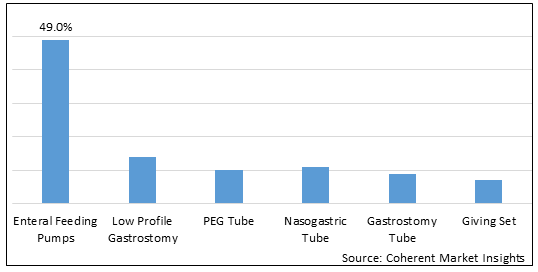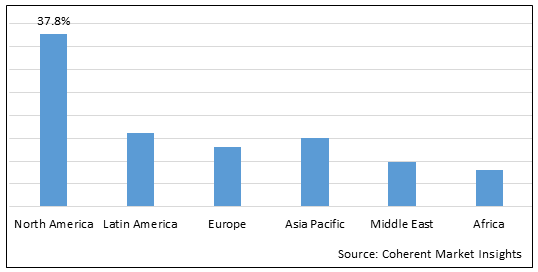Neonatal And Preterm Infants Enteral Feeding Devices Market is estimated to be valued at USD 3.59 Bn in 2025 and is expected to reach USD 5.09 Bn in 2032, exhibiting a compound annual growth rate (CAGR) of 5.1% from 2025 to 2032.
Analysts’ Views on the Global Neonatal and Preterm Infants Enteral Feeding Devices Market:
Increasing product launches by key market players is expected to drive the market growth over the forecast period. For instance, in January 2021, Sciontec Development Limited, a medical device company, announced that it had invested U$S 971,168 Million to expand its product range and international distribution channels. This investment will enable NGFS’s new DoubleCHEK device to be manufactured in the U.K. and initiate commercialization through a U.K.-wide sales rollout in 2021.
Figure 1. Global Neonatal and Preterm Infants Enteral Feeding Devices Market, Market Share (%), by Product Type, 2025

To learn more about this report, Download Free Sample
Global Neonatal and Preterm Infants Enteral Feeding Devices Market- Driver
Increasing product launches by key market players: Increasing product launches by key market players is expected to aid the growth of the global neonatal and preterm infants enteral feeding devices market over the forecast period. For instance, in May 2021, QMD, a medical technology company, announced that it had launched a new Degania line of Bi-Port and Single-Port Feeding Tubes for nasogastric feeding. This product launch will expand the company’s enteral feeding portfolio.
Figure 2. Global Neonatal and Preterm Infants Enteral Feeding Devices Market Share (%), by Region, 2025

To learn more about this report, Download Free Sample
Global Neonatal and Preterm Infants Enteral Feeding Devices Market- Regional Analysis
Among regions, North America is estimated to hold a dominant position in the global neonatal and preterm infants enteral feeding devices market over the forecast period. North America holds 37.8% of the market share due to the increasing product approvals by regulatory authorities, which is expected to drive the market over the forecast period.
Global Neonatal and Preterm Infants Enteral Feeding Devices Market- Impact of Coronavirus (COVID-19) Pandemic
Since the COVID-19 virus outbreak in December 2019, the disease spread to over 100 countries across the globe, and the World Health Organization (WHO) declared it a public health emergency on January 30, 2020.
COVID-19 affected the economy in three main ways: by directly affecting the production and demand of drugs, by creating disruptions in distribution channels, and through its financial impact on firms and financial markets. Due to nationwide lockdowns, several countries, such as China, India, Saudi Arabia, the U.A.E., Egypt, and others, faced problems with the transportation of drugs from one place to another.
However, the COVID-19 pandemic had a positive impact on the global neonatal and preterm infants enteral feeding devices market. The increasing prevalence of people suffering from COVID-19, who are at risk of being malnourished, requires nutritional support of food that is provided by nasoenteric feeding tubes, and this is expected to drive the market growth. For instance, according to the data published by BioMed Central Journal, in July 2020, the novel coronavirus may infect the gastrointestinal tract, neurological systems, and kidneys which can affect the nutrition delivery among COVID-19 patients. However, nutrition is an important element of care. The nutritional assessment and the early nutritional care management of COVID-19 patients is required. Patients suffering from COVID-19 requires nutritional support, and thus, this increases the demand for nasoenteric feeding tube.
Neonatal and Preterm Infants Enteral Feeding Devices Market Report Coverage
| Report Coverage | Details | ||
|---|---|---|---|
| Base Year: | 2024 | Market Size in 2025: | USD 3.59 Bn |
| Historical Data for: | 2020 To 2024 | Forecast Period: | 2025 To 2032 |
| Forecast Period 2025 to 2032 CAGR: | 5.1% | 2032 Value Projection: | USD 5.09 Bn |
| Geographies covered: |
|
||
| Segments covered: |
|
||
| Companies covered: |
Amsino International, Inc., Cardinal Health, Medtronic, BD, Moog Inc., Avanos Medical Inc., Abbott, Enteral Access Technologies Ltd, Danone, Applied Medical Technology, Inc., Fresenius Kabi, Qosina, and Romsons |
||
| Growth Drivers: |
|
||
| Restraints & Challenges: |
|
||
Uncover macros and micros vetted on 75+ parameters: Get instant access to report
Global Neonatal and Preterm Infants Enteral Feeding Devices Market Segmentation:
The global neonatal and preterm infants enteral feeding devices market report is segmented into product type, end user, and region.
Among all segmentation, the product type segment has the highest potential due to the increasing launch of enteral feeding pumps by key market players.
Global Neonatal and Preterm Infants Enteral Feeding Devices Market Cross Sectional Analysis:
In the product type segment, enteral feeding pumps hold a dominant position in North America due to increasing product launches by key market players. For instance, in October 2022, Rockfield Medical Devices Limited, a commercial-stage medical device company, announced that it had received approval from U.S. Food and Drug Administration Mobility+ Enteral Feeding System. The Mobility+ Enteral Feeding System is a portable, lightweight, non-electronic, enteral feeding system that delivers liquid nutrition formula to an enteral access device (feeding tube) in users aged 2 years and over, in clinical or home care settings
Global Neonatal and Preterm Infants Enteral Feeding Devices Market: Key Developments
Global Neonatal and Preterm Infants Enteral Feeding Devices Market: Key Trends
Increasing adoption of technology to safely position feeding tubes: Recent advances in access devices, feeds, and pumps have made enteral feeding a viable option for many clinicians and their patients. The adoption of technology for overcoming complications related to nasoeneteral feeding tubes such as dislodgement (improper positioning of the tube) by the employment of technology is expected to drive the market growth over the forecast period. For instance, Kangaroo Feeding Tube with IRIS Technology, a feeding tube developed by Cardinal Health, a multinational health care services company, is the first disposable feeding tube with an integrated real-time imaging system to visually aid in small bore feeding tube placement. Kangaroo IRIS is designed to: See anatomy in real-time during feeding tube placement, safely and confidently position small-bore feeding tubes at the bedside
Global Neonatal and Preterm Infants Enteral Feeding Devices Market: Restraint
Increasing product recall by regulatory authorities: Increasing product recall by regulatory authorities due to safety issues associated with systems designed to help healthcare professionals place feeding tubes properly is expected to hamper the market growth over the forecast period. For instance, in March 2022, the U.S. Food and Drug Administration announced a recall of the Avanos Medical CORTRAK 2 Enteral Access System of Avanos Medical, Inc., a medical technology company making clinical medical devices. The Avanos Medical CORTRAK 2 Enteral Access System is designed to help trained healthcare personnel place medical feeding tubes into the stomach or small bowel of patients who need to receive nutrition through the tube. Avanos Medical, Inc. is recalling the Cortrak2 Enteral Access System because there have been reports of injuries and patient deaths after nasoenteric or nasogastric tubes have been misplaced when this device is used to help with their placement
Thus, key market players are focued on manufacturing more efficient neonatal and preterm infants enteral feeding devices
Global Neonatal and Preterm Infants Enteral Feeding Devices Market- Key Players
The major players operating in the global neonatal and preterm infants enteral feeding devices market Amsino International, Inc., Cardinal Health, Medtronic, BD, Moog Inc., Avanos Medical Inc., Abbott, Enteral Access Technologies Ltd, Danone, Applied Medical Technology, Inc., Fresenius Kabi, Qosina, and Romsons
Definition: Neonatal and Preterm Infants Enteral Feeding Devices used for enteral feeding for preterm infants or low birth weight infants. Early full enteral feeding, however, increases nutrient intake and growth rates, accelerate intestinal physiological, metabolic, and others, and reduce the risk of complications associated with intravascular devices for fluid administration
Share
Share
About Author
Komal Dighe is a Management Consultant with over 8 years of experience in market research and consulting. She excels in managing and delivering high-quality insights and solutions in Health-tech Consulting reports. Her expertise encompasses conducting both primary and secondary research, effectively addressing client requirements, and excelling in market estimation and forecast. Her comprehensive approach ensures that clients receive thorough and accurate analyses, enabling them to make informed decisions and capitalize on market opportunities.
Missing comfort of reading report in your local language? Find your preferred language :
Transform your Strategy with Exclusive Trending Reports :
Frequently Asked Questions
Select a License Type
Joining thousands of companies around the world committed to making the Excellent Business Solutions.
View All Our Clients